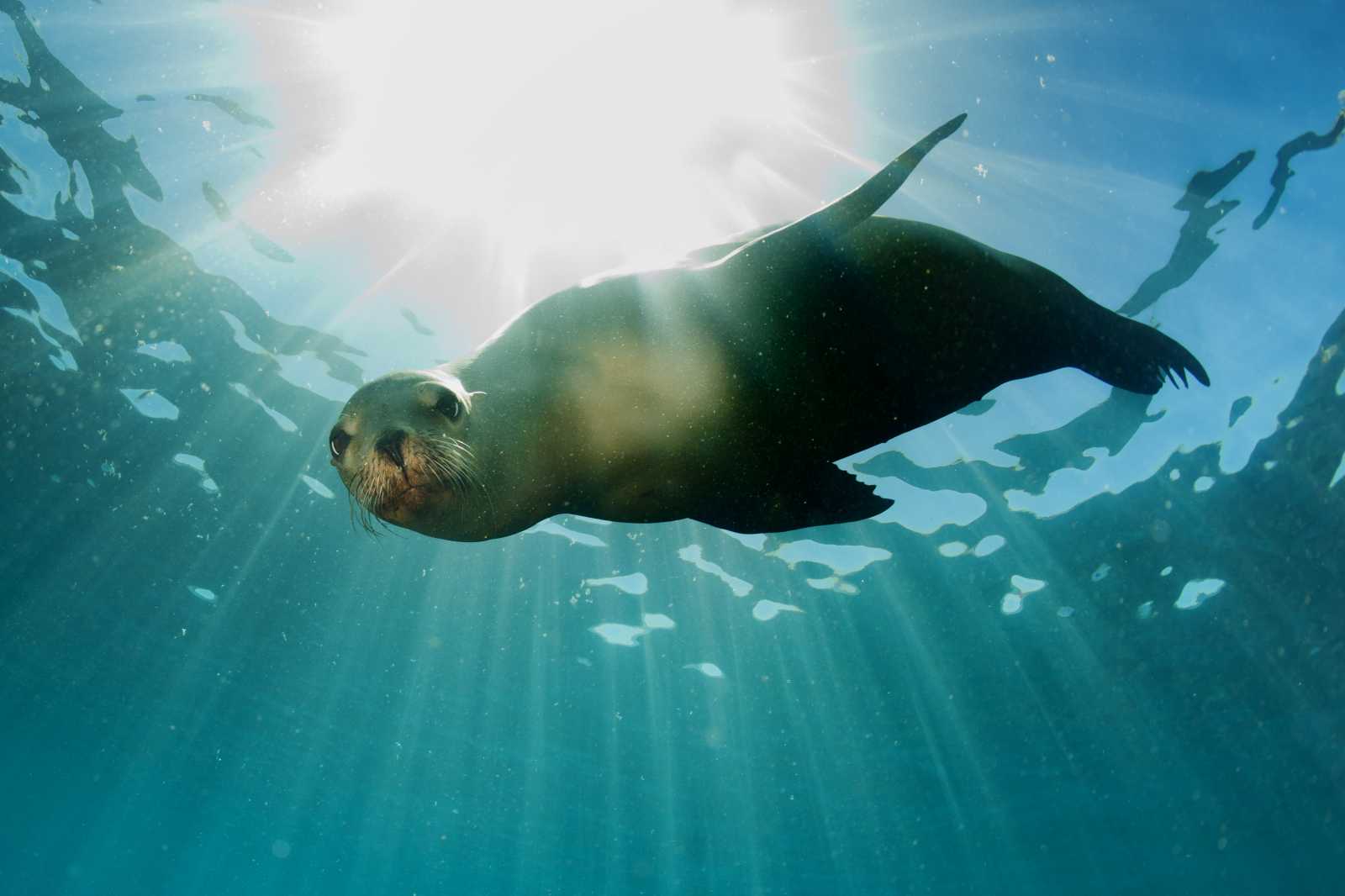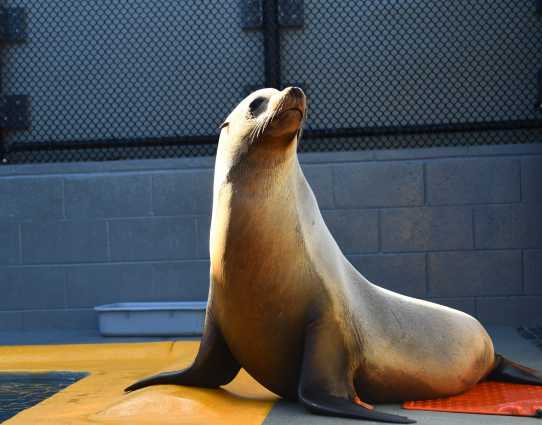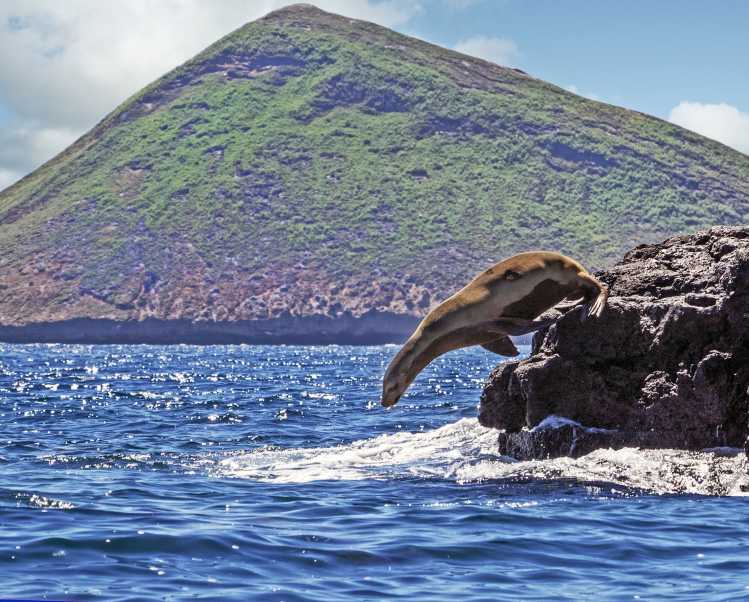
California Sea Lion
Zalophus californianus
Learn More About Sea Lions
California sea lions are known for their intelligence, playfulness and noisy barking. Their fur color ranges from chocolate brown seen in males to a lighter, golden brown seen in females. Another key difference between males and females is that male sea lions are much larger—reaching up to 600 to 850 pounds and 7 feet in length. Females grow to 200 to 250 pounds and up to 6 feet in length.
These sea lions have a dog-like face, and starting at 4 years old, males develop a bony bump on top of their skull known as a sagittal crest, which is fully developed by 7 years old. The top of a male sea lion’s head often gets lighter in color with age.
As a member of the otariid or “walking seal” family, California sea lions have large flippers that they use to walk on land. Another distinctive physical characteristic is their external ear flaps.
What do they sound like?
Meet Our Patient: Bluegrass
California sea lion Bluegrass was spotted in San Francisco at PIER 39, a popular sea lion hangout, with a severe wound to his face. He was brought to our hospital where our expert veterinary team determined Bluegrass had been shot.
Bluegrass underwent intensive surgery and was left with only one eye. But sea lions are known to thrive in the wild with just one eye as their other senses, like smell and hearing, help compensate.
After weeks of rehabilitative care, Bluegrass’ gunshot wound healed fully, and he was released back to the wild with a second chance at life.

The greatest threats to marine mammals are caused by people, but we can also be their greatest champions.
Sign up for email from The Marine Mammal Center to stay updated on how you can be an advocate and champion for marine mammals like California sea lions.
Habitat & Population Status
California sea lions are coastal animals found from Vancouver Island, British Columbia, to the southern tip of Baja California in Mexico. However, there is a distinct population of California sea lions at the Galápagos Islands. In fact, there was a third population of sea lions in the Sea of Japan, but they became extinct around the time of World War II.
Sea lions breed mainly on offshore islands, ranging from Southern California's Channel Islands to Mexico, although a few pups have been born on Año Nuevo and the Farallon Islands in Central California as well.
The California sea lion population is growing steadily and is estimated at around 257,000 individuals. They can be observed in many coastal spots in California, one of the most well-known being PIER 39 in San Francisco.

California Sea Lion Research at The Marine Mammal Center
{"image":"\/Animals\/Patients\/California sea lions\/2020\/csl-oso-by-bill-hunnewell-c-the-marine-mammal-center-1.jpg","alt":"California sea lion","title":"Loss of Neuron Connectors in the Brains of Sea Lions with Epilepsy","link_url":"https:\/\/www.marinemammalcenter.org\/publications\/loss-of-neuron-connectors-in-the-brains-of-sea-lions-with-epilepsy","label":"Research Paper","type":"publication"}

{"image":"\/Animals\/Patients\/California sea lions\/csl-by-bill-hunnewell-c-the-marine-mammal-center-4.jpg","alt":"California sea lion with mouth open, showing teeth","title":"Using Tooth Layers to Determine California Sea Lion Age","link_url":"https:\/\/www.marinemammalcenter.org\/publications\/using-tooth-layers-to-determine-california-sea-lion-age","label":"Research Paper","type":"publication"}

{"image":"\/Animals\/Patients\/California sea lions\/csl-by-bill-hunnewell-c-the-marine-mammal-center-1.jpg","alt":"California sea lion eating a fish","title":"New Technique for Diagnosing Lung Parasite Infections in Sea Lions","link_url":"https:\/\/www.marinemammalcenter.org\/publications\/new-technique-for-diagnosing-lung-parasite-infections-in-sea-lions","label":"Research Paper","type":"publication"}

{"image":"\/Animals\/Patients\/California sea lions\/cropped-images\/csl-by-bill-hunnewell-c-the-marine-mammal-center-3-2-318-2819-2252-1600897445.jpg","alt":"California sea lion","title":"Establishing Dosing Requirements for an Anti-Fungal Medication in Young Sea Lions","link_url":"https:\/\/www.marinemammalcenter.org\/publications\/establishing-dosing-requirements-for-an-anti-fungal-medication-in-young-sea-lions","label":"Research Paper","type":"publication"}

Establishing Dosing Requirements for an Anti-Fungal Medication in Young Sea Lions
Read MoreBreeding & Behavior
Female California sea lions reach sexual maturity around 3 years of age, whereas males are sexually mature at 5 years old. Sea lions return to their rookeries (or breeding grounds) in Southern and Central California each year where females give birth to their pups in early summer. In fact, most California sea lions are born in the first two weeks of June each year.
Newborn California sea lions weigh 13 to 20 pounds and stay with their mother for about a year as they nurse and learn important survival skills, like how to swim and find food on their own.
Mothers recognize their pups on crowded rookeries through smell and vocalizations. In turn, pups learn to recognize the smell and vocalizations of their mothers. A few weeks after females give birth, they are ready to mate again before the males migrate north toward British Columbia.
California sea lions are very social animals—groups often rest closely packed together at favorite haul-out sites on land or float together on the ocean's surface in groups called "rafts."
They are sometimes seen porpoising, or jumping out of the water, presumably to speed up their swimming. Sea lions have also been seen surfing breaking waves.
As opportunistic eaters, California sea lions feed on squid, octopus and small schooling fish like herring, anchovies and sardines. In turn, sea lions are preyed upon by orca whales and great white sharks, and face a variety of other threats in the wild, including human activity, such as gunshots and entanglement in ocean trash.


















